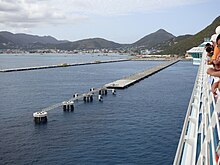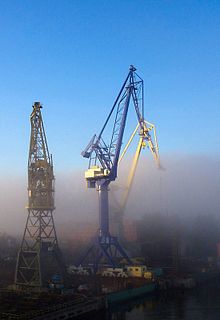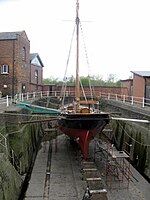Dock



The worddock(fromDutchdok) inAmerican Englishrefers to one or a group of human-madestructuresthat are involved in the handling of boats or ships (usually on or near ashore). InBritish English,the term is not used the same way as in American English, it is used to mean the area of water that is next to or around awharfor quay. The exact meaning varies among differentvariants of the English language.
"Dock" may also refer to a dockyard (also known as ashipyard) where the loading, unloading, building, or repairing of ships occurs.
History
[edit]The earliest known docks were those discovered inWadi al-Jarf,anancient Egyptianharbor,of PharaohKhufu,dating from c.2500 BC located on theRed Seacoast.[1][2]Archaeologists also discovered anchors and storage jars near the site.[3]
A dock fromLothalinIndiadates from 2400 BC[4][5]and was located away from the maincurrentto avoid deposition ofsilt.[6]Modernoceanographershave observed that the ancientHarappansmust have possessed great knowledge relating totidesin order to build such a dock on the ever-shifting course of theSabarmati,as well as exemplaryhydrographyandmaritime engineering.[6]This is the earliest known dock found in the world equipped to berth and service ships.[6]
It is speculated that Lothal engineers studied tidal movements and their effects on brick-built structures, since the walls are ofkiln-burnt bricks.[7]This knowledge also enabled them to select Lothal's location in the first place, as theGulf of Khambhathas the highest tidal amplitude and ships can besluicedthrough flow tides in the riverestuary.[7]The engineers built atrapezoidalstructure, with north–south arms of average 21.8 metres (71.5 ft), and east–west arms of 37 metres (121 ft).[7]
British English
[edit]
InBritish English,a dock is an enclosed area of water used for loading, unloading, building or repairingships.Such a dock may be created by building enclosing harbour walls into an existing natural water space, or by excavation within what would otherwise be dry land.
There are specific types of dock structures where the water level is controlled:
- A wet dock orimpounded dockis a variant in which the water is impounded either by dock gates or by alock,thus allowing ships to remain afloat at low tide in places with hightidal ranges.The level of water in the dock is maintained despite the rising and falling of the tide. This makes transfer of cargo easier. It works like a lock which controls the water level and allows passage of ships. The world's first enclosed wet dock with lock gates to maintain a constant water level irrespective of tidal conditions was theHowland Great Dockon theRiver Thames,built in 1703. The dock was merely a haven surrounded by trees, with no unloading facilities. The world's first commercial enclosed wet dock, with quays and unloading warehouses, was theOld DockatLiverpool,built in 1715 and held up to 100 ships. The dock reduced ship waiting giving quick turnarounds, greatly improving the throughput of cargo.
- Adrydockis another variant, also with dock gates, which can be emptied of water to allow investigation and maintenance of the underwater parts of ships.
- Afloating dry dock(sometimes justfloating dock) is a submersible structure which lifts ships out of the water to allow dry docking where no land-based facilities are available.
Where the water level is not controlledberthsmay be:
- Floating, where there is always sufficient water to float the ship.
- NAABSA(Not Always Afloat But Safely Aground) where ships settle on the bottom atlow tide.Ships using NAABSA facilities have to be designed for them.[8]
Adockyard(or shipyard) consists of one or more docks, usually with other structures.
American English
[edit]InAmerican English,dockis technically synonymous withpierorwharf—any human-made structure in the water intended for people to be on. However, in modern use,pieris generally used to refer to structures originally intended for industrial use, such asseafoodprocessing orshipping,and more recently forcruise ships,anddockis used for almost everything else, often with a qualifier, such asferry dock,swimming dock,ore dockand others. However,pieris also commonly used to refer to wooden or metal structures that extend into the ocean from beaches and are used, for the most part, to accommodate fishing in the ocean without using a boat.
InAmerican English,the term for the water area between piers isslip.
In parts of both the US and Canada
[edit]In thecottage countryofCanadaand theUnited States,a dock is a wooden platform built over water, with one end secured to the shore. The platform is used for the boarding and offloading of small boats.
-
A boat dock onLake MichiganinChicago.
See also
[edit]- Dry dock:a narrow basin that can be flooded and drained to allow a load to come to rest on a dry platform
- Ferry slip:a specialized docking facility that receives a ferryboat
- Floating dock (impounded)
- Floating dock (jetty):a walkway over water, made buoyant with pontoons
- Harbor
- Jetty:a landing stage or small pier at which boats can dock or be moored.
- Marina:a boat basin offering dockage and other service for small craft
- Mole (architecture)
- Ore dock
- Pier:a raised walkway over water, supported by widely spread pilings or pillars
- Pontoon (boat):a buoyant device, used to support docks or floating bridges
- Quay:a concrete, stone, or metal platform lying alongside or projecting into water for loading and unloading ships.
- Slipway:a ramp on the shore by which ships or boats can be moved to and from the water
- Wharf:a fixed platform, commonly on pilings, where ships are loaded and unloaded
References
[edit]- ^Boyle, Alan (15 April 2013)."4,500-year-old harbor structures and papyrus texts unearthed in Egypt".NBC.
- ^Marouard, Gregory; Tallet, Pierre (2012)."Wadi al-Jarf - An early pharaonic harbour on the Red Sea coast".Egyptian Archaeology.40:40–43.Retrieved18 April2013.
- ^Tallet, Pierre (2012)."Ayn Sukhna and Wadi el-Jarf: Two newly discovered pharaonic harbours on the Suez Gulf"(PDF).British Museum Studies in Ancient Egypt and Sudan.18:147–68.ISSN2049-5021.Retrieved21 April2013.
- ^Codebò, Mario (2013)."ARCHAEOASTRONOMICAL SURVEYS IN LOTHAL (INDIA)".www.archaeoastronomy.it.Retrieved10 May2020.
- ^Frenez, D. (2014).Lothal re-visitation Project, a fine thread connecting Intis to contemporary Raveena (Via Oman).UK: BAR. pp. 263–267.ISBN9781407313269.
- ^abcRao, pages 27–28
- ^abcRao, pages 28–29
- ^Baltic and International Maritime Council;ASBA; SML,NYPE 2015 Time Charter Party, explanatory notes(PDF),Clause 1(d), archived fromthe original(PDF)on 31 March 2017,retrieved31 March2017.NYPE is theNew York Produce Exchangeform, a standard charter agreement for shipping.
Bibliography
[edit]- Rao, S. R. (1985).Lothal, a Harappan Port Town (1955–62).New Delhi: Archaeological Survey of India.OCLC60370124.
External links
[edit]


